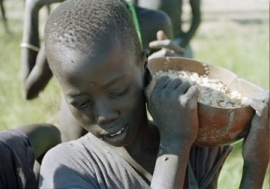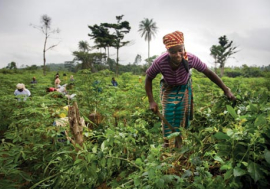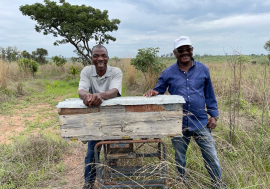A harvest of hope for African farmers
A harvest of hope for African farmers
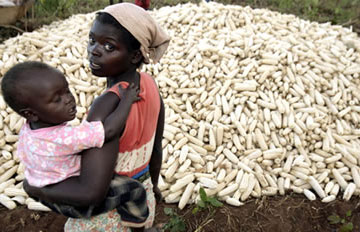 Thanks to low-priced fertilizer and other farming inputs provided by the government,Malawi’s maize harvests have been bountiful.
Thanks to low-priced fertilizer and other farming inputs provided by the government,Malawi’s maize harvests have been bountiful.In a world still shaken by skyrocketing food prices and the sometimes violent street protests that have accompanied them (see Africa Renewal July 2008), the search is on for ways to increase food production in Africa and other chronically hungry regions. Tito Jestala, who farms a tiny plot of land in Chiseka, Malawi, thinks he has the answer.
In 2005, more than 30 of his neighbours died of malnutrition in one of the periodic droughts that have swept Southern Africa. Even in a good year, he told the UK newspaper The Independent, he could coax barely 250 kilogrammes of maize from his exhausted land. But over the past two years his harvest has tripled, producing plenty of food for his family and leaving more than enough to sell at the local market.
The difference, Mr. Jestala says, is fertilizer. For years this basic input was simply beyond his means and those of millions of other African farmers. Costing the equivalent of about $50 a bag, fertilizer was just too expensive to use. And buying it on credit was too great a risk for farmers at the mercy of unreliable rains and poor-quality seeds. But in 2005 the government of President Bingu wa Mutharika began subsidizing fertilizers and high-yielding seeds for Malawi’s smallholders. The action cut fertilizer prices by 80 per cent and slashed the cost of hybrid maize seeds from 600 kwacha per bag to 30.
The impact was dramatic. The following year Malawi’s maize harvest more than doubled, to 2.7 mn tonnes. It rose again in 2007 to 3.4 mn tonnes — enough to feed the nation and sell 400,000 tonnes to the UN’s World Food Programme (WFP) and hundreds of thousands of tonnes more to neighbouring countries, generating $120 mn in sales. The formerly aid-dependent country even donated 10,000 tonnes of maize to the WFP’s nutrition programme for people living with HIV/AIDS.
This year the government plans to spend $170 mn to expand the programme in the hope of reaching more farmers and capitalizing on higher world maize prices. “As long as I am president,” Mr. Mutharika was reported to have told his cabinet in 2007, “I don’t want to be going to other capitals begging for food.”
‘A very bold decision’
In fact, say experts at the UN Food and Agriculture Organization (FAO), Malawi’s turnaround is the result of a combination of factors, including the return of sufficient rain, the incentives offered by higher world food prices and increased government investments in other parts of the country’s rural economy.
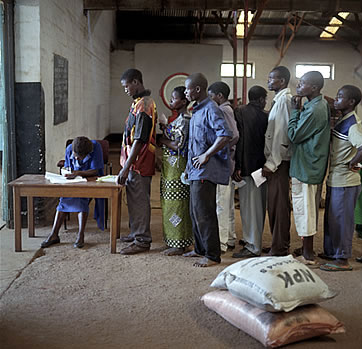 Malawian farmers queue up to purchase subsidized fertilizer: Although other African countries are showing interest in Malawi’s example, some donor institutions remain wary.
Malawian farmers queue up to purchase subsidized fertilizer: Although other African countries are showing interest in Malawi’s example, some donor institutions remain wary.Yet there is little doubt that the decision to make high-quality seeds and fertilizers affordable for smallholders like Mr. Jestala has been the key to Malawi’s success. The subsidy programme is already being seen as a model by a growing number of African governments and international development and agriculture agencies.
But the programme has encountered difficulties in gaining acceptance from donors. In 1999 the government had introduced a more modest programme of free “starter packs” of fertilizer and seeds for family farmers in an effort to boost production. The results were impressive, but the subsidies ran afoul of the pro-market policies of the World Bank and International Monetary Fund (IMF), which argued that subsidies were “crowding out” commercial sales and constituted undue government interference in the economy. Under considerable pressure from these financing institutions, the programme was phased out. The IMF also insisted that Malawi sell much of its national grain reserve to pay off the debts of the state-owned maize marketing agency.
Most Malawian farmers, however, were too poor to pay commercial rates for fertilizer and seeds. As a result, maize yields plunged. When drought struck in 2001 neither farmers nor the government had adequate grain stores to see them through, and more than a thousand people are estimated to have died. Then after the failed 2005 harvest left 5 million of Malawi’s 13 million people on the brink of starvation, the newly elected government of President Mutharika defied the donors and launched the subsidy scheme with its own funds.
That move proved decisive, Kanayo Nwanze, vice-president of the UN’s International Fund for Agricultural Development (IFAD), told Africa Renewal. “It was a very bold decision to provide subsidies for seeds and fertilizers over the objections of the development partners,” he said, noting that during one meeting with senior Malawian officials a furious representative of a donor country had stormed out of the room. “But the government stood its ground and said ‘We’re going to do it. It is our programme and we’re going to do it.’”
With success literally growing all around them, “the next year the donors supported it,” Mr. Nwanze noted. It also made good economic sense, he continued, since the savings from reduced imports and increased export sales generated three to four times more revenue than the subsidies cost.
The importance of the Malawi subsidy programme for the rest of Africa, Mr. Nwanze observed, is that “it is a story that can easily be repeated in other parts of Africa” and has the potential to produce big gains in a short time at relatively modest expense. A growing number of countries, including Zambia, Ghana, Senegal and Kenya, have announced plans for similar subsidies and more governments are expected to follow suit.
The African Development Bank (ADB), often a critic of state interventions in economic affairs, announced in May that it had established a special fund to mobilize financial resources for greater fertilizer production and use, including subsidized sales to family farmers. The move was part of a $1 bn increase in the ADB’s farm lending portfolio.
Failed policies
The new emphasis on smallholder farming and food self-sufficiency represents a sharp break with past policy by donors, international financial institutions and African governments alike. Since at least the 1980s, African governments have pursued structural adjustment policies mandated by the World Bank and IMF. These included focusing on high-value commercial and export crops and developing non-agricultural pursuits for those displaced by such activities. Government subsidies and marketing programmes were said to be too costly, to impede private business involvement and to be prone to mismanagement and corruption. Government withdrawal from agriculture, donors insisted, would allow the private sector to move in.
But as FAO and World Bank data show, investment in African agriculture instead went into a steep decline. This was reflected in reduced use of fertilizers and improved seed varieties, fewer agricultural extension and marketing services and a steady drop in crop yields, soil fertility and rural incomes.
A 2007 analysis of agricultural lending to Africa by the World Bank’s Internal Evaluation Group confirmed that countries had been pressured into privatizing marketing and extension services and ending farm subsidy programmes to make room for private entrepreneurs and investors. But, the analysis added, such businesses too often failed to materialize.
In addition, FAO Director-General Jacques Diouf noted at a June 2008 food summit in Rome, the percentage of official development assistance devoted to agriculture dropped from 17 per cent to 3 per cent between 1980 and 2005.
The shift in emphasis away from agriculture, in particular smallholder food production, was no oversight. Under the pro-market, trade liberalization policies pursued by international financial institutions and many bilateral donor agencies, governments were advised to stay out of farming and allow commercial growers to produce niche-market products like flowers and seasonal fruits instead of low-value food items.
The view of these groups was expressed succinctly by then US Agriculture Secretary John Block, who, according to journalist and activist Martin Khor, told a world trade conference in 1986 that “the idea that developing countries should feed themselves is an anachronism from a bygone era. They could better ensure their food security by relying on US agricultural products, which are available in most cases at lower cost.”
‘It was a very bold decision to provide subsidies for seeds and fertilizers over the objections of the development partners. The government stood its ground.’
— Kanayo Nwanze, vice-president, International Fund for Agriculture Development
Dwindling donor support, the World Bank evaluation asserted, encouraged neglect by national governments as well. “As the decline in lending continued, so too did the decline in recognition within governments that agriculture was central to development.” World Bank advice and structural adjustment policies have had a major impact on African agriculture, the study acknowledged, “but results have fallen short of expectations.”
‘An absolute disaster’
In the view of many agronomists and development economists, the results have been little short of ruinous. After being a net food exporter in the 1970s, Africa is now heavily reliant on commercial imports and emergency aid, the FAO reports. Some 42 African countries depend on imports in even the best of times. It is the only world region where crop yields per hectare have remained stagnant (see graph below) and where as many as one in three people are chronically malnourished.
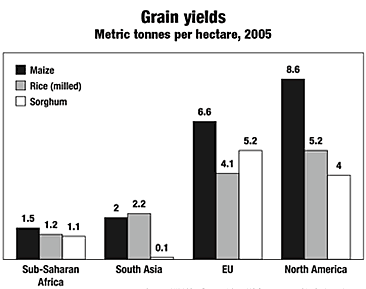
“The end of government subsidies to African farmers because of structural adjustment programmes was an absolute disaster,” says Akin Adesina, the vice president of the Alliance for a Green Revolution in Africa (AGRA), a non-governmental rural development initiative headed by former UN Secretary-General Kofi Annan that is a leader of international efforts to revive African agriculture.
“Today African farmers are almost the only ones in the world who receive absolutely no government support of any kind,” he told Africa Renewal, noting that farmers in wealthy countries currently receive more than $300 bn in government payments annually. African farmers “are left on their own to sink or swim, and as we have seen they are simply sinking.”
“What AGRA is saying,” Mr. Adesina continues, “is that there is a need now to recognize that government has to play a role in subsidizing African farmers. The key with subsidies is to do them in ways that reach the poor and also build the market. We are calling those smart subsidies, and we are calling for smart subsidies all across Africa. If Malawi can do it, everyone can.”
IFAD’s Mr. Nwanze agrees. Previously, he explains, the depth of poverty in African farming communities made it impossible for most farmers to buy the improved seeds, fertilizers, tools and other inputs they need. “I can’t for the life of me understand why [subsidies] have been blocked in the developing world. It’s totally ridiculous. Here we are talking about an environment where most farmers have no access to credit and no access to inputs and we’re telling governments that you cannot subsidize agricultural production.”
For three decades, Mr. Nwanze notes, IFAD has worked with governments in developing countries to provide credit to family farmers, increase access to inputs and connect them to local and regional markets. “We have seen it work time and again. To me, smallholder agriculture is the key for those countries.”
Arguing with success
But have the global food price shock, recognition of the economic importance of African agriculture and the Malawi success story brought the era of “sink or swim” policies to an end? Have they prompted a generous helping hand to Africa’s hard-pressed, mostly female family farmers? Not quite.
Agronomists, economists and governmental and intergovernmental policymakers agree that neither subsidies nor fertilizer is by itself a solution to Africa’s complex agricultural problems. Making African farming profitable, sustainable and productive will require land reform, political empowerment of rural communities, access to local, national and global markets and long-term investments in irrigation, sustainable fertilizer use and soil management, health and education, modern farm technology and extension services, and transport and communications systems. These strategic investments are detailed in the Comprehensive Africa Agriculture Development Programme of the continent’s development blueprint, the New Partnership for Africa’s Development (NEPAD).
There are also doubts about global and national political commitment. Only six of Africa’s 53 countries have followed through on a 2003 commitment to devote 10 per cent of their national budgets to agriculture.
Internationally, the recent collapse of talks at the World Trade Organization, in part over the issue of subsidized Northern food exports to poor countries, suggests that powerful farm lobbies in wealthy countries still covet privileged access to developing countries’ markets at the expense of local producers. Europe’s system of trade preferences for African and other developing country imports, dubbed the “everything but arms” initiative to by EU trade ministers, has so many obstacles to agriculture imports that it is only half-jokingly referred to as the “everything but farms” agreement by critics.
Nor is everyone persuaded by Malawi’s model subsidy programme, despite its success. Michael Morris, a World Bank economist and expert on fertilizer subsidies, confirms that there has been a shift in the Bank’s thinking about smallholder agriculture and government subsidies. But he argues that government support for family farmers should be smaller, “smarter” and better targeted than in the past.
“The Malawi government is doing many things well” with its subsidy programme, he told Africa Renewal. However, “We do have some disagreement about tactics.” Those disagreements, he says, concern the costs, whether the subsidies are creating dependencies or laying the basis for self-sustaining commercial sales, and whether the subsidies are reaching the intended beneficiaries.
“We’re always being charged that the bank is being ideological and dogmatic about subsidies because economic theory tells us subsidies are bad,” Mr. Morris notes. “The bitter experience was that when you had subsidies on fertilizer it really attracts . . . politically and economically powerful people who go after the fertilizer. I think that explains the ambivalence that the Bank has had about subsidies. What has changed is the recognition that things simply weren’t happening on the ground. The private sector wasn’t getting the job done.”
Under such circumstances, he concedes, governments can target “market-smart” subsidies that “build the basis for a sustainable private-sector-led input distribution system that can function on its own.” Even then, he cautions, “the conditions for using those subsidies are pretty rigorous. You really want to be targeting them not only at the end user but also at different stages along the whole supply chain. . . . There are lots of opportunities to use subsidies to lower costs in those various stages,” including by providing financing and training for importers and distributors and by stimulating demand by educating farmers and distributing small demonstration packs.
Governments and donors must also evaluate the cost of fertilizer subsidies against other needs. Mr. Morris estimates that fertilizer subsidies now consume 60 per cent of Malawi’s agriculture budget. “That’s just a huge amount. There are many other things — extension services, irrigation, research — that are not being done as a result.” Unless African governments incorporate an “exit strategy” into their subsidy programmes, he concludes, “you commit larger and larger amounts of money into something that will never be able to pay for itself. We need to think of other opportunities and other options. We have to pick our spots.”
To date, however, Malawi’s subsidy programme has more than paid for itself. And the government has cracked down at the first signs of abuse, by sacking a senior cabinet minister for selling subsidy coupons to wealthy farmers and by toughening eligibility requirements and oversight procedures.
In a video address to a special meeting of the UN Economic and Social Council on the world food crisis in May, President Mutharika called on the international community to help Africa support its farmers: “International stakeholders like the World Bank . . . should not continue with the feeling that they have all the solutions in Washington. They should listen to policymakers at the local level and learn from that.”
The lesson from Malawi is that the seeds of food security can grow with just a little fertilizer and a lot of political commitment at the top.
AGRA: For a green revolution in Africa
Addressing delegates to an international Feeding the World conference at Wageningen University in the Netherlands in September, the chair of the non-governmental Alliance for a Green Revolution in Africa (AGRA), former UN Secretary-General Kofi Annan, declared: “For Africa to again feed itself and rejoin the league of agriculture-exporting regions, we need an African green revolution,” to increase the productivity and profitability of the continent’s family farmers. Since its launch in 2006 with funding from the US Rockefeller and Bill and Melinda Gates Foundations, AGRA has emerged as a major player in efforts to increase African food production. It promotes wider use of improved seeds and fertilizers, better extension and farming methods and easier access to credit for smallholders. It also calls for greater investment in rural infrastructure such as roads, irrigation systems and information technologies. In June AGRA signed an agreement with the UN Food and Agriculture Organization to help develop African “breadbasket areas” into major food-producing zones. AGRA also initialled an agreement with a US government development agency, the Millennium Challenge Corporation, to strengthen its foodsecurity programmes.










